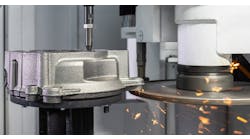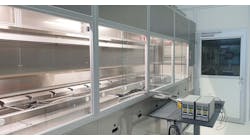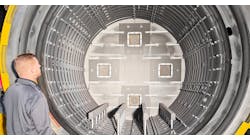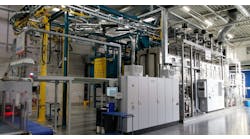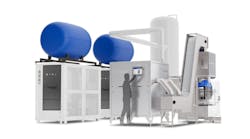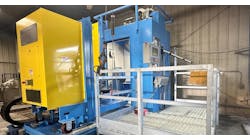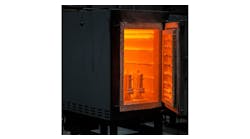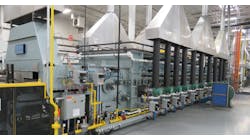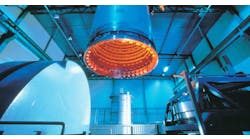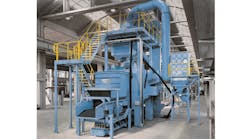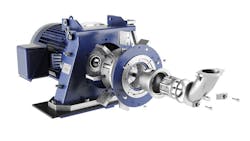Reshoring and nearshoring, and manufacturers’ urgency to reduce their supply-chain risks, have North American metalcasting booming. From brake disks to skillets and pipe fittings, many foundries have been running almost non-stop since the end of the global pandemic. That’s great for business, but keeping up with the demand may require them to push blasting equipment to its limits – and beyond.
That may mean cutting back scheduled maintenance, which can have costly consequences. Without proper care, equipment damage may extend beyond wear parts to essential components of blasting machines – escalating repair needs, prompting unplanned downtime, and significantly increasing costs.
Foundries often struggle to keep older batch blast machines operating. Transitioning to a continuous blast process is a smarter solution. Upgrading to a single continuous machine automates and tightly controls the blasting process, and it will enhance workplace safety, increase throughput, and add process capacity – so it’s possible to sustain or surpass current production levels, efficiently and cost-effectively.
Switching to continuous blasting
Numerous U.S. and Mexican foundries have adopted continuous blasting following in high-speed vertical, green sand molding lines from our DISA colleagues. The last thing they want is for the blast process to put the brakes on a new molding line.
Similarly, diecasters and other industries want a high-performance, continuous process. They can treat more delicate aluminum parts, more quickly, by using mesh-belt machines that don’t “tumble” parts. In both cases, a continuous process means more production headroom on the same line.
In just the past five years, we saw first-hand with our installation that continuous blasting has revolutionized production in Mexico, especially as European automotive manufacturers expand regional operations. Those OEMs, already well-versed in the efficiency of Continuous Through-Feed Tumblast (CT) machines, are making them integral to their new production lines. For foundries aiming to keep pace with global leaders, adopting CT machines is not just an upgrade: it’s a necessity.
CTs fit easily into high-volume foundry production because they adjust their speed automatically to fit the current process speed. The barrel rotation speed and abrasive throughput settings can be programmed in advance to match different volumes of castings and line speed.
Because the CT handles mixed and single product runs, the line can keep running after a pattern change and there’s no need to segregate castings until the blasting is completed. With fully integrated, continuous, and flexible production there’s no need for intermediate stocking (storing castings as blast machines are reset.) There’s no manual intervention and no floor transportation required within the line either.
Wheelabrator’s inline CT machines make the best use of valuable floor space and support a much cleaner work environment because a continuous process makes it possible to control and capture all the dust from the entire production line.
Continuous blasting in action
One of MAT Foundry Group’s facilities is a great example of how a continuous process driving high production volumes – over 60,000 tons/year of automotive parts, like brake discs, calipers, and brackets –while maintaining reliable quality on two DISAMATIC molding lines. Installed as part of a Norican Complete Foundry, the CTs easily keep up with the high-speed vertical molding machines.
MAT’s manager describes the process as “very stable, fast and efficient” with a very smooth surface finish and a 99% uptime rate. For him, “reliable high-quality is one of the big advantages of the CT, and it’s the main reason we chose it.”
And the Wheelabrator CTs are so fast and economical that it’s cost-effective to simply blast all gates, scrap, and other returns before re-melting rather than separating them beforehand. Clean scrap requires less energy for remelting and produces minimal slag. That means less slag removal for operators, lower melting costs (less energy, less labor for slag removal) and, with less slag, a higher quality melt and reduced scrap.
Due to full automation, continuous blasting requires very little oversight which gives very low labor costs. With continuous surface finishing, an entire green sand line can be run by two or three operators and a CT also ties in well with other automation options, for example, synchronizing sub-processes like molding, pouring, cooling and shakeout using machine-to-machine (M2M) integration.
If you are running batch blasting now, try calculating its total operating cost per ton of processed castings. Taking an overall view of production instead of just adding up energy, shot, and wear-part consumption gives a clearer view of blasting costs at casting level. MAT Group did this calculation and found nothing could touch continuous processing.
Budget-conscious upgrades
If a new machine is not an option, large or small changes can improve the capacity and quality of the blast process. For example, if you run your shot blast machine for 28 days straight, the blast wheels must be able to go the distance.
Particularly for smaller jobbing foundries, upgrading blast wheels can achieve the performance of a new machine at a fraction of the cost. Engineered for effectiveness and ease of maintenance, Wheelabrator’s EZX wheel combines cast wear parts and a manganese steel housing for excellent durability with straightforward direct-drive technology. Thicker blades yield longer wear life, and a patented impeller shape reduces the abrasive consumption.
Digitalizing blasting is another way to push equipment hard, more safely. Whether it’s an existing machine or a new continuous one, digitalization gives operators the ability to collect data and monitor the process closely. Perhaps more important, it can slash abrasive and energy use, free up maintenance teams and prevent downtime.
Whichever machine you operate, a magnetic separator to recover molding and core sand during shot blasting is worth the investment. Wear parts really don’t like foundry sand: 1% of sand in your abrasive mix cuts your part life in half.
North American foundries are thriving, making now the perfect time to invest in future-ready solutions. Foundries are seeking higher throughputs on smaller footprints, reduced handling and loading, super-efficient blasting processes, and increased automation.
Brian Kuptz is the Sales Director - North America for Wheelabrator.
